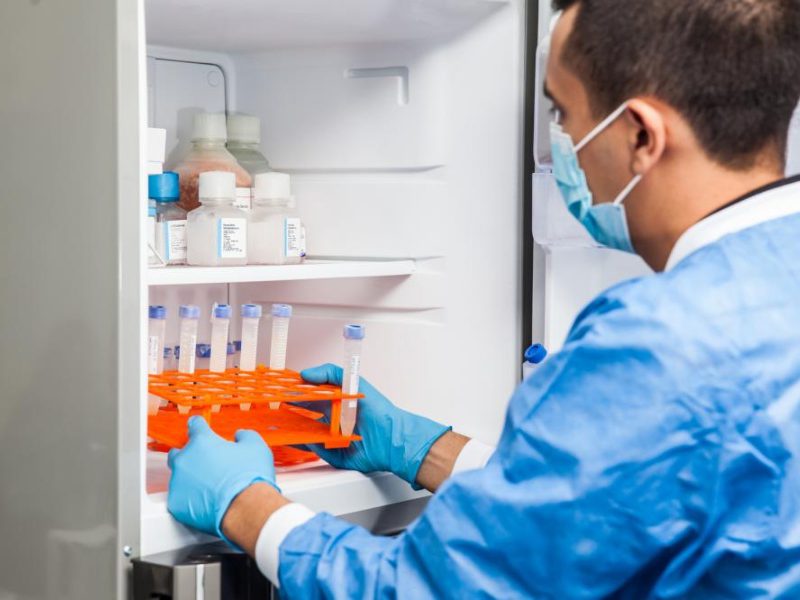DIN 58371 is used in blood storage facilities. It deals with terminology, requirements and testing in this area.
DIN 58371 has been an absolute standard in the field of blood storage for many years. It also deals with the setting point criteria for the maximum allowed temperature (in °C) in devices.
The most important requirements of DIN 58371 are:
- The temperature should always be 4ºC (2ºC).
- There must be a safety device to prevent the temperature of the product (blood products) from cooling below 2 ° C.
- Useful content should never deviate more than 3% from the calculated / specified value.
- All surfaces must be resistant to common wipes disinfectants.
- The equipment must have alarm functions.
- The alarm must be guaranteed for at least 12 hours, even in the event of a power failure (backup battery, potential-free failure signalling contacts).
- They must have a reference body to simulate the temperature of the product.
- Must be able to lock to be protected against unauthorized access.
- …
What is the purpose of medical device certification according to 93/42 / EEC (Medical Device Directive)?
Medical device (MDD) certification ensures that products certified to this standard are always uniform and understandable, which increases the quality of medical devices and patient safety.
According to DIN 58371 (blood storage) or DIN 58375 (plasma storage), MDD certification offers even greater security for your process, as there are also areas such as selling, commissioning (including documentation)…
The certification also ensures that the devices used are always intended for this purpose.
As a result, a blood/plasma storage device certified in accordance with MDD ensures legal and investment security.
In 1959, Dr Michael Rubenstein used a process called plasmapheresis to save the life of a patient with a severe case of blood disorder. It was the first time in history. Nowadays, a more sophisticated version of the same treatment is used to treat extreme cases of COVID-19.
How does plasmapheresis work? Is it effective? How can we ensure that this or other therapies reach the maximum number of people who need them?
Many hospitals around the world have begun using a procedure called “convalescent plasma therapy”. The purpose is to treat severe cases of COVID-19. To begin with, it is necessary to get the plasma from someone who has recovered from the virus. This plasma is injected into an infected person. The treatment provides the patient with vital antibodies to reinforce the response efforts against the virus.
Early results of studies indicate that convalescent plasma therapy could become a promising treatment in response to the pandemic, although, it is still too early to say whether it will be introduced worldwide as a treatment against coronavirus.
What is needed to ensure the safety of this therapy? Since there may be a delay from the time of blood collection to plasma transfusion, medical staff should ensure that antibodies do not degrade during that time. Degradation makes plasma ineffective in the fight against the virus. The easiest way to avoid this is to freeze the plasma at the intended temperature.
Recently, the ISBT working group has indicated that samples should be frozen as soon as possible at a minimum temperature of -20°C (preferably lower) and frozen until administered. Therefore, hospitals must quickly freeze all blood and plasma samples that they obtain to prevent the degradation of the plasma antibodies that they will use on their COVID-19 patients.
Coreco equipment
B Medical Systems plasma freezers are designed for the safe storage of plasma and blood components with an adjustment point of -32°C to -41°C and with a net volume capacity of 106 to 763 L (3.74 to 26.95 cubic feet). All our models are designed with state-of-the-art cooling technology, and superior insulation. We also offer contact shock freezers that are designed for rapid freezing of blood plasma or biological samples up to a central temperature below -30°C in less than an hour. Both our plasma storage freezers and contact shock freezers are classified as class ll (a) medical devices, according to MDD 93/42/EEC or class II medical devices according to 21CFR Part 864.9700.
Through our contact shock freezers and plasma storage freezers, we guarantee safe handling and storage of the COVID-19 convalescent plasma, thus collaborating in the fight against the new coronavirus.


 Key aspects of buying a laboratory fridge
Key aspects of buying a laboratory fridge